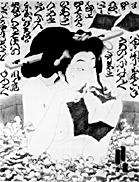

Opening on April 9, the Allen Memorial Art Museum will host Masami Teraoka: From Tradition to Technology, the Floating World Comes of Age, the exhibit spans Teraoka's work from the mid-seventies to the present and addresses a wide variety of contemporary issues, ranging from the invasive role of technology in modern life and environmental degradation to the Japanese/American culture clash and the AIDS epidemic. Teraoka's work over the last quarter century is difficult to categorize, combining elements from traditional Japanese ukiyo-e, American Pop Art, and more recently, late Gothic and Renaissance religious paintings in a way that provides a provocative look into modern society.
Numerous attempts have been made over the last twenty-five years to pigeonhole Masami Teraoka - as a Japanese artist, as an American artist, and as an Asian-American artist, yet while he is all of these, his highly individual combination of wit, imagination, and skill defies simplistic categorization. Teraoka's images transcend the boundaries of time, space, and culture, and must be interpreted in their own terms.

The essentially immediate, open-minded nature of his art is perhaps best explained in his own terms. "I don't want my paintings to preach," Teraoka has said, "I am interested in the moment of confrontation with life when our psyche becomes shocked and naked - a vacuumed mind-set situation. A strong art is direct but does not have any fa&00e7;ade. It comes in a raw state." Perhaps the highlight of the exhibit will be when Teroaka himself comes to Oberlin to discuss his work at the end of April.
Japanese born Teraoka was raised in a family of textile designers and was exposed to a vast assortment of artistic influences at a very young age. He moved to the United States to study art at the Otis Art Institute in Los Angeles. It was soon after his move to the United States that his signature fusion of Japanese ukiyo-e and American Pop Art was developed, and this fusion earned him regional success in the Los Angeles area in the late 1960s. Throughout the seventies he gained more popularity and national recognition, eventually to be given a solo show at the Whitney Museum of Modern Art in New York City.
Teraoka then relocated to Hawaii, where the geographic location and ethnic diversity seemed better suited to his position on the cusp between the two cultures. The next fifteen years proved to be a very prolific time for Teraoka, and his works were shown and collected in major museums around the world.
During the late sixties Teraoka solidified his Pop-influenced ukiyo-e style that commented on the glaring differences between Japanese and American cultures, a theme that has dominated his work ever since. The seventies and eighties saw Teraoka address more difficult and discomforting issues, such as the global spred of mass consumerism and the deconstruction of the natural environment. Though these new themes were presented with irony and humor, the overall tone of his work became considerably darker and less whimsical that that of his early art. In 1986, he was shocked and disturbed by the contraction of AIDS by a child of a close friend and this led to his AIDS series which continues today.
From Tradition to Technology, was brought to Oberlin through the generous support of the Oberlin Shansi Memorial Association, and will remain here until June first. Charles Mason, AMAM's Curator of Asian Art, will present a public lecture on the exhibit on Tuesday, April 13, at 12:30 p.m. in the Stern Gallery. On Thursday, April 22, Masami Teraoka will give a lecture on his work in the Art Building's Fisher Hall at 5 p.m. On Friday April 23 from 7 to 9 p.m. there will be a reception for the artist and the exhibition in conjunction with the AMAM's twice annual Art Afterhours.
Geisha in Bath: This Teraoka painting will be displayed at AMAM. (photo courtesy AMAM)
Copyright © 1999, The Oberlin Review.
Volume 127, Number 18, April 2, 1999
Contact us with your comments and suggestions.